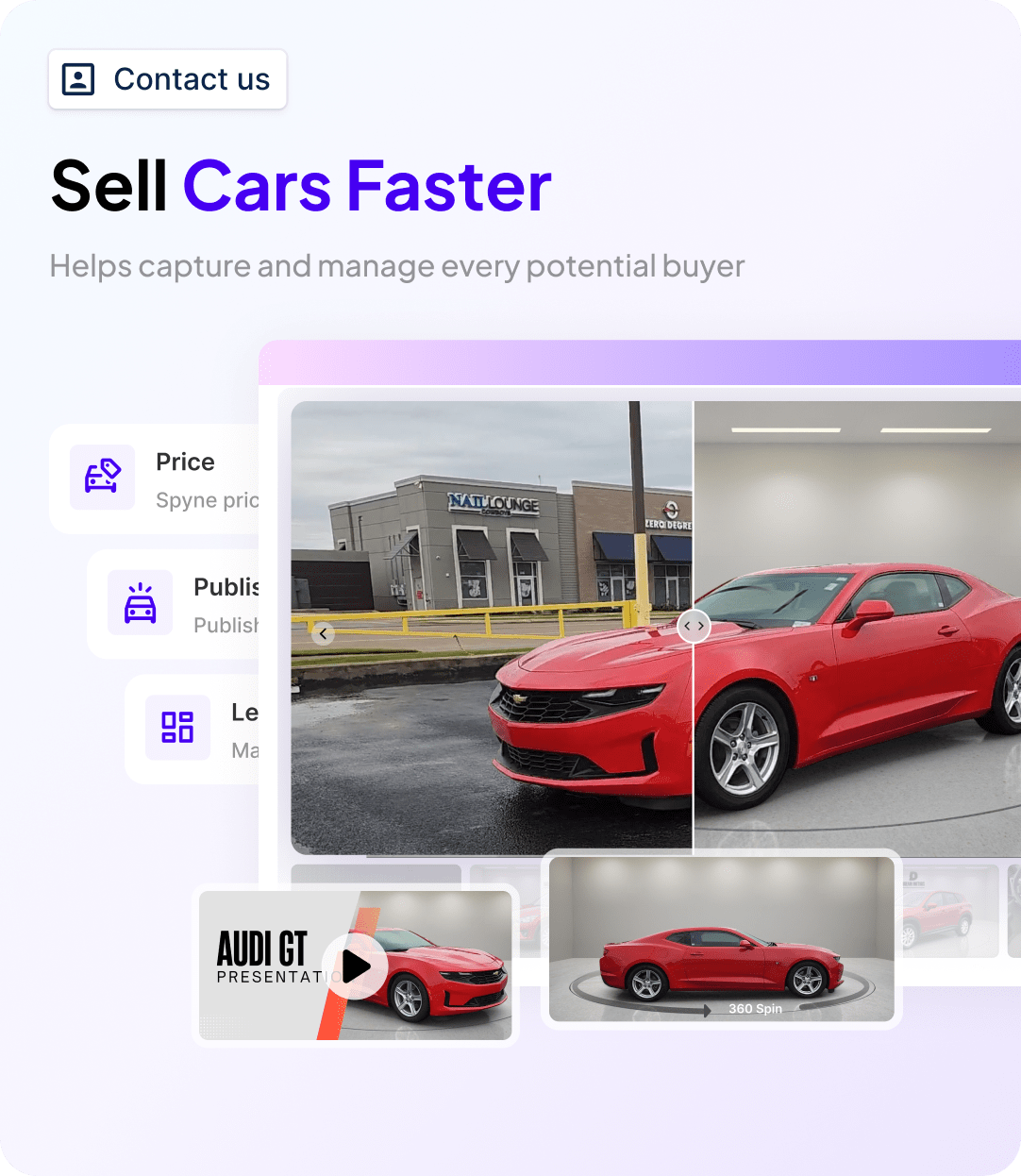Selling or trading a car isn’t what it used to be. Customers walk into dealerships already having done their research; they know what their car is worth, or at least they think they do. And in a world where price transparency can make or break a deal, dealerships can’t afford to guess. That’s where vehicle pricing tools come into play.
These tools are helpful enough to be the backbone of fair, fast, and profitable deals. If you are valuing a trade-in, pricing a used car to sell quickly, or adjusting inventory pricing based on local demand, the right automotive pricing software can save time, build trust, and protect your bottom line.
What Is a Vehicle Pricing Tool?
A vehicle pricing tool is software designed to calculate a car’s current market value based on real data. We’re talking about recent sales, similar listings, location trends, vehicle condition, mileage, and more.
There are tools used for different needs:
1. A new car pricing tool helps price fresh inventory based on manufacturer incentives, market trends, and competing dealerships.
2. A used car pricing tool or used car appraisal software digs deep into current demand, mileage, condition, and similar listings nearby to find the right price.
3. For trade-ins, dealer appraisal software, car appraisal software, and vehicle appraisal software let you give fast, accurate offers on the spot, no back-and-forth, no guesswork.
But it doesn’t stop there. These tools often integrate with your full operation. Think car dealership auction pricing software, managing your car inventory, running smooth vehicle assessments, even providing high-quality car photography for online listings. Some include features like 360 spin, virtual tour, and full vehicle inspection support, giving buyers a complete look before they step foot on the lot.
Top 10 Car Appraisal Tools For Your Dealership
Gone are the days when dealers needed to quote vehicles manually. Here’s a rundown of 10 top car valuation tools that dealerships can rely on:
- Kelley Blue Book (KBB): A trusted name in automotive pricing software, KBB offers detailed pricing for new and used cars, including trade-in values.
- Edmunds True Market Value (TMV): This car pricing tool provides accurate pricing based on real-world transactions and regional data.
- NADA Guide: Widely used by dealerships, NADA’s used car appraisal software delivers comprehensive pricing for vehicles of all types.
- Black Book: Known for its auction-based data, Black Book is a go-to for car dealership auction pricing software.
- TrueCar: A consumer-friendly vehicle appraisal software that also helps dealers with transparent pricing.
- CarGurus: This platform combines user reviews with pricing data, making it a versatile car dealer appraisal software.
- AutoTrader: AutoTrader’s dealership pricing tool integrates market trends and inventory data for accurate appraisals.
- VAuto: A powerful auto appraisal software that helps dealers manage car inventory and price competitively.
- Manheim Market Report (MMR): Ideal for auction-focused dealerships, MMR is a leading used car pricing software for wholesale pricing.
- Cox Automotive’s VinSolutions: This vehicle appraisal software integrates with CRM systems, offering appraisals alongside inventory management.
Top 5 Reasons Why Vehicle Pricing Tool is Important
Pricing is your reputation, your profit margin, and the key to moving inventory. If you are behind the desk at a busy dealership or trying to get the best deal on your trade-in, knowing what a vehicle is really worth makes all the difference.
Here’s why vehicle pricing tools are a must.
1. Clear, Honest Pricing Builds Trust
No one wants to feel like they’ve overpaid or undersold. With tools like used car pricing software, everyone can see the fair market value up front. It levels the playing field, builds trust, and takes the awkwardness out of price talks because both sides can see the same data.
2. Trade-Ins That Don’t Drag On
Trading in a car used to mean lots of back and forth, but not anymore. Dealer appraisal software gives dealerships the ability to make quick, accurate offers on the spot based on current market data, not gut feelings. It saves time and makes the process smoother for everyone.
3. Better Pricing Means More Sales
With a solid dealership pricing tool, dealers can price vehicles to match what’s happening in the local market, not just a random markup. That means competitive pricing that grabs attention and gets cars off the lot faster, without eating into your margins.
4. No More Wasted Time on Manual Estimates
Appraising vehicles manually eats up hours. Car appraisal software gives you instant, reliable numbers so you can keep things moving, doesn’t matter if you’re working a busy sales floor or reviewing your 360 vehicle inventory at the end of the day.
5. Make Decisions Backed by Real Data
Guesswork doesn’t cut it when you’ve got dozens (or hundreds) of vehicles to manage. Automotive pricing software pulls in real-time data to help with everything from setting prices to deciding which cars to promote or discount. It’s smart but also necessary.
![]()
Types of Vehicle Pricing Tools And What They’re Good For
Not every vehicle is the same, and neither are the tools used to price them. From brand-new cars fresh off the truck to trade-ins with some miles on them, pricing tools help sellers stay competitive and buyers feel confident. The right vehicle pricing tool can save time, avoid guesswork, and keep things moving smoothly at the dealership. Here’s a look at the different types and where each one fits in.
1. New Car Pricing Tools
When pricing a brand-new vehicle, you need more than just the sticker price. Tools like TrueCar and Edmunds help show not only MSRP but also invoice prices and any current manufacturer incentives. These tools give dealerships an edge in staying competitive while helping buyers understand what they should be paying.
2. Used Car Pricing Tools
Used cars come with more variables. Kelley Blue Book (KBB) and NADA Guides are well-known platforms that factor in mileage, condition, region, and market demand. This kind of used car pricing software is essential for fair, accurate pricing if you’re selling, trading in, or buying.
3. Dealership Appraisal Tools
For dealerships, speed and accuracy matter. Tools like Spyne go beyond just pricing—they also handle car inventory photos, vehicle inspections, and full car damage assessment. Spyne’s AI-driven platform creates professional-level car photography, 360 spin views, and even virtual tours, helping cars stand out online and sell faster. These features make it a powerful dealership appraisal tool that combines pricing insight with visual presentation.
4. Auction Pricing Tools
Buying or selling through auctions? Tools like Black Book and Manheim specialize in tracking wholesale and auction values. This car dealership auction pricing software helps dealers stay on top of fast-changing prices and make informed bidding or selling decisions.
5. Consumer-Focused Pricing Tools
Websites like CarGurus and AutoTrader give everyday buyers insight into what a car is worth. These platforms often include price comparisons, dealer ratings, and features like high-quality photos, 360 views, and virtual walkarounds. Dealers listing vehicles here need to stay sharp because customers are doing their homework.
6) General Pricing Tool
Many pricing tools offer customization options, enabling users to adjust pricing strategies according to their inventory and market trends. They often include features for reporting and analytics to track performance over time.
How Do Vehicle Pricing Tools Actually Work?
You now know about vehicle pricing tools but what’s really going on behind the scenes? While they may seem simple on the surface, these tools are powered by a lot of data and some smart tech working in the background. Let’s break it down:
1. They Start by Collecting Data
Everything begins with the numbers. These tools pull in data from all over like recent car sales, dealership transactions, auction results, and even local market trends. The goal? To understand what cars like yours are actually selling for right now, not just what someone thinks they’re worth.
2. You Enter the Car’s Details
Next, the user adds in specifics about the car. That usually includes the make, model, year, mileage, trim, and condition. Some tools also accept vehicle inspection data or even images, thanks to platforms like Spyne, which can include car photography, car interior visuals, and 360 spin features for a more accurate picture of the vehicle’s condition.
3. The Tool Analyzes Everything
Here’s where the smart part kicks in. The software runs all that info through its system, comparing it with the latest trends and similar listings. It considers things like depreciation, how in-demand that specific car is, and what people are paying for similar vehicles in your area.
4. You Get a Value Range
Once it crunches the numbers, the tool gives you a value or sometimes a range. This often includes a retail price, trade-in value, and even what it might sell for in a private sale. Some advanced tools also show visuals, like a car 360 spin view or detailed shots of the interior, especially if they’re connected to visual platforms like Spyne.
5. They Keep It Fresh with Regular Updates
The car market doesn’t stand still and neither do these tools. The best automotive pricing software updates its data frequently to keep up with market shifts, ensuring that the values you get are accurate and up to date.
What are the Factors Influencing Vehicle Pricing?
Several factors influence the output of a vehicle pricing tool. You need to understand these to interpret valuations better:
- Vehicle Condition: A car’s physical state, including car interior quality and vehicle inspection results, heavily impacts its value.
- Mileage: Higher mileage typically lowers a vehicle’s value, as it indicates wear and tear.
- Market Demand: Popular models in high demand fetch higher prices, while oversupplied models may see lower valuations.
- Location: Regional differences in demand and supply affect pricing. A car pricing tool adjusts for local market conditions.
- Age and Depreciation: Older vehicles generally have lower values due to depreciation, though classic cars may be exceptions.
- Optional Features: Upgrades like leather seats or advanced tech can increase a car’s value.
- Economic Factors: Fuel prices, interest rates, and economic conditions can influence buyer behavior and pricing.
Role of Technology in Vehicle Appraisals
Technology has changed the way cars are appraised these days. Nobody relies on someone’s opinion, we now have tools that can analyze a car’s value based on real-time data.
These tools consider factors like the car’s condition, how much demand there is for it in your area, and current market trends. This makes appraisals even more accurate and faster, whether you’re at a dealership or selling privately. For dealerships, it helps stay competitive and price cars fairly. For buyers, it creates a more transparent and trustworthy process.
What is a New Car Pricing Tool?
A new car pricing tool is basically a tool that helps you figure out the right price for a new car. It gathers info from different places like what other dealers are charging, manufacturer prices, and any promotions going on and then shows you a fair price. If you’re buying a car, it helps you make sure you’re not overpaying. For dealers, it makes sure they’re offering competitive prices. It gives everyone the info they need to make smarter, easier car deals.
What is a Used Car Pricing Tool?
A used car pricing tool is a specialized subset of vehicle pricing tools focused on pre-owned vehicles. These tools, like KBB, NADA, or Black Book, provide valuations for used cars based on factors like mileage, condition, and market trends. They’re important for:
- Buyers: To avoid overpaying for a used car.
- Sellers: To set a fair asking price.
- Dealerships: To appraise trade-ins and price inventory competitively.
Unlike new car pricing tools, used car appraisal software places greater emphasis on vehicle assessment and historical data, as each used car’s condition is unique. Features like car photography, 360 spin visuals, and detailed car interior reports enhance their accuracy, helping users make informed decisions.
Conclusion
When it comes to buying or selling a car, vehicle pricing tools have really started to make things easier. Gone are the days of relying on gut feelings or guesswork when setting or negotiating prices. Now, these tools give everyone, dealers and buyers alike, access to real-time market data, making the whole process a lot more transparent and straightforward.
For dealerships, they’re a huge help in keeping prices competitive while also giving you a clearer picture of how your inventory’s moving. Instead of wondering if you’re offering a fair deal, you can rest assured that your pricing aligns with current trends. For buyers, these tools make the process feel a lot less like a guessing game. No more worrying if you’re getting ripped off or paying too much. You know exactly what you’re looking at.















